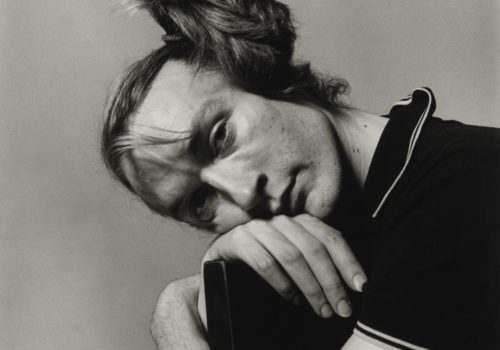The Peter Hujar exhibition at MAPFRE Foundation in Barcelona (Peter Hujar: Speed of Life) constitutes the most detailed account to date of the work of American photographer Peter Hujar, featuring over 150 photos that represent his work from the 1950s to the 1980s. On the occasion of this exceptional show, The Eye of Photography invites you to discover the great story behind one famous photograph, Lavinia Co-op, named after a dancer.
One day in 1980, the British performance troupe Bloolips visited Peter Hujar’s loft home-studio at Twelfth Street and Second Avenue, in New York, for a portrait session. The six-member gender-absurdist ensemble were in town performing their revue Lust in Space at the Theatre for a New City, based in a converted church two blocks down the Avenue.
As a genre – and almost as a sport – group portraiture fascinated Peter Hujar: the psychological tensions that play out between individual and collective, conformity and introspection, engagement and withdrawal, present a portraitist with unique challenges. But he soon found that his exposures of Bloolips were yielding nothing of value to him. As revealed in five contact sheets, the troupe remained relentlessly “on” that day: they performed to the camera and played off one another with the energy and rapport of exactly what they were: a madcap act in their groove, performing well on the road. As Bloolips leader Bette Bourne said later, Hujar did not hide his disappointment at what a theatrical publicity photographer would have regarded as a successful shoot.
When he shifted his attention to each of the performers alone, Hujar had his best luck with Lavinia Co-op, a dancer who had been with Bloolips since their founding in 1977. In the frame Hujar would go on to print, Lavinia is seated facing the back of the simple black bentwood chair that provides the sole prop in many of the photographer’s portraits. (Hujar’s friend Vince Aletti was present when the artist, in one of his sudden rages, later smashed that chair to splinters against the studio floor.) Lavinia casts his face to one side and rests his cheek on the knuckles of one hand; a loose pony tail, perched atop his pitched head, trails over his ear. Double lines of white piping on the collar and sleeve of his dark sailor shirt lend emphasis to his unostentatious pose.
Hujar shot whole rolls of some of the other Bloolips, but only seven frames of Lavinia, as if he knew he had quickly got all he could ask for. Lavinia Co-op is an uncanny image, and in no simple way. It is tempting at first to describe it as full of mixed gender cues: Lavinia was slender and gamine, but in this moment his features look uncomplicatedly masculine, while his smoky gaze and offhand hair arrangement skew feminine. Spend time with the life-size likeness, though, and you may come to agree that what Hujar represents is precisely what Lavinia performed: not a blending of conventional cues but a form of beauty indifferent to gender signals. (Think of the sexless beauty one admires in a bird or a tiger. Now make it human.)
In Bloolips, Lavinia has recalled, “drag was kind of radical, things would be ‘wrong’… You weren’t impersonating women [but] working on your androgynous side… developing something that wasn’t stereotypical… coming from drag and opening a door here to somewhere else… Finding another way.” In this briefest of visual dialogues between artist and muse, viewers can find that way, too.
Joel Smith
Joel Smith is the photography curator of the Morgan Library & Museum, in New York, USA.
Peter Hujar : Speed of Life
January 27 to April 30, 2017
MAPFRE Foundation
Carrer de la Diputació, 250
08007 Barcelona
Spain
www.fundacionmapfre.org
















